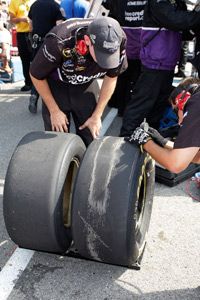Heat and Tire Wear
Racing tires are designed to wear. A well-used tire that is wearing evenly will show uniform abrasion across the entire contact patch. Some tracks act like a grinder or cheese grader on the contact patch of the tire, causing the tire to wear faster. The excess rubber comes off in the form of rubber dust and molten pieces referred to as marbles. The rubber also gets imbedded in the grain of the track. If you have ever watched a NASCAR race and seen the black strip around the track, that's called the racing groove. The groove is nothing more than worn rubber piled on top of more rubber. The groove normally has the most grip on the track but in some cases, drivers will find a secondary groove to drive in because the excess rubber will actually hamper the handling of their car. The marbles accumulate toward the outside wall of the race track and can be a very slippery place to drive. How can more rubber be slippery? Just as the name implies, the small rubber balls act like marbles underneath the tires, causing the cars to slide.
Tires also go through heat cycles that can change the grip of the tire. In general, a tire will get harder after each heat cycle. Experienced drivers take care of their tires and don't allow them to build up too much heat. A more evenly heated tire will go through less heat cycles and will have optimum grip for a longer period of time.
Advertisement
All but four races in the 2008 NASCAR Sprint Cup racing season take place on oval tracks. Because of the high banking on several of the tracks, stock cars and trucks in NASCAR's three series can reach speeds approaching and in some cases, above 200 mph (321.9 km/h). Centrifugal force allows the cars to reach the high speeds, but as you can imagine, the tires wear out very quickly. Tire wear is good and bad at the same time. NASCAR teams don't like tire wear because the cars are slower on worn tires; however, proper tire wear is crucial to tire safety. If a tire does not wear properly, the rubber can vulcanize or cure. Racing tires are not completely cured when they come from the manufacturer. Because of the excessive heat generated by high speeds and significant g-forces, engineers leave part of the curing process to happen during the tire's use. Tire engineers understand the heat will change the composition of the rubber so they plan for the on-track vulcanization process. This is why it's important to acquire accurate data during tire testing.
For more information about tires, NASCAR and other related topics, follow the links below.
Related HowStuffWorks Articles
- Quiz Corner: NASCAR Quiz
- How Tires Work
- How NASCAR Works
- How NASCAR Race Cars Work
- NASCAR Drivers
- NASCAR Race Car Tracks
- How NASCAR Safety Works
- How the Daytona 500 Works
- What makes NASCAR engines different from street car engines?
- NASCAR
- NASCAR Results
More Great Links
Sources
- Gibson, John. Stock Car Racing Magazine. "Racing Suspension - Tire Stagger." (Aug. 10, 2008) http://www.stockcarracing.com/techarticles/scrp_0805_tire_stagger/index.html
- Goodyear Blimp official website. (Aug 16, 2008) http://www.goodyearblimp.com/
- Goodyear Racing official website. (Aug. 12, 2008) http://www.racegoodyear.com/
- Inside Racing Technology. "The Racing & High-Performance Tire." March, 2004. (Aug 13, 2008) http://www.insideracingtechnology.com/tirebkexerpt3.htm
- Kelley, Dick. Stock Car Racing Magazine. "NASCAR's Rain Tire: The saga of a tire in search of some water." (Aug. 12, 2008) http://www.stockcarracing.com/techarticles/1589_rain_tires_good_year/index.html
- NASCAR.com. "Goodyear sets forth a plan to address NASCAR tires." Aug. 2, 2008. (Aug. 10, 2008) http://www.nascar.com/2008/news/headlines/cup/08/02/goodyear.actions.indy/
- O'Connor, Mary Catherine. "Goodyear Using RFID for NASCAR from Cradle to Grave." RFID Journal. July 19, 2006. (Aug. 13, 2008) http://www.rfidjournal.com/article/articleview/2500/1/1/
- Packman, Tim. "Tech Q & A: Rob Lopes." NASCAR.com. Nov. 7, 2002. (Aug. 12, 2008) http://www.nascar.com/2002/kyn/tech/qa/11/07/qa_lopes/index.html
